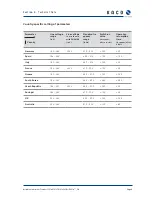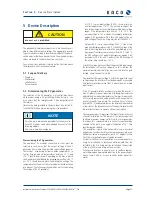
Installation Instructions Powador 1501xi/2501xi*/3501xi/4501xi/5001xi**_EN
Page 23
S e c t i o n 8 ·
T r o u b l e s h o o t i n g
Fault
Cause of fault
Troubleshooting/Explanation
The inverter is active but
does not feed into the
grid. The display shows:
Start at 125 V meas. xxx
V (measured voltage is
greater than 125 V).
The inverter has inter-
rupted the grid feed due
to a fault.
After an interruption to the grid feed due to a fault (line failure,
overtemperature, overload, etc.), the inverter waits a country-
specifi c time period (see section 4, Technical Data) before
switching back over to grid feed mode. With faulty grids, inter-
ruptions can occur during the day. Notify your solar installer if
the inverter shuts down regularly over a period of several weeks
(more than 10 times per day).
The inverter stops
supplying power to
the grid shortly after
being switched on, even
though there is suffi cient
sunlight.
Faulty grid separation relay
in the inverter.
Although there is suffi cient sunlight, the inverter feeds into the
grid only for a few seconds before switching off again. During
the short grid feed period, the inverter shows that the power
being fed into the grid is between 0 and 5 W. If the inverter is
defi nitely receiving suffi cient generator power, the grid separa-
tion relay is presumably faulty, thus preventing the inverter from
connecting.
The inverter’s display
shows the error message
“Failure PV overvoltage”.
The voltage on the solar
generator has risen to
500 V.
The inverter is designed for a maximum input voltage of 500 V
from the solar generator.
An incorrect module arrangement or the incorrect dimensioning
of the solar installation can result in this voltage being exceeded.
To protect the inverter, it does not begin feeding into the grid
until the input voltage once again falls below 500 V.
Noise emission from the
inverter.
Particular ambient condi-
tions.
When there are certain ambient conditions, the units may emit
audible noises. The following causes may be determining factors
in this regard:
Line interference or line failure caused by particular loads
–
(motors, machines, etc.) which are either connected to
the same point on the grid or located in the vicinity of the
inverter.
In cases of dynamic weather conditions (frequent switching
–
between sunny and cloudy conditions) or strong insolation, a
light hum may be audible due to the increased power.
With particular grid conditions, resonances may form between
–
the unit’s input fi lter and the grid, which may be audible even
when the inverter is switched off.
People with very sensitive hearing (particularly children) may
–
be able to hear the high-frequency hum caused by the invert-
er’s operating frequency of approx. 18 kHz.
Such noise emissions do not affect the operation of the inverter.
Nor can they lead to loss of effi ciency, failure, damage or to a
shortening of the unit’s service life.
If the measures described in this guide do not assist in clearing the fault, please notify your installer.
In order for our factory customer service department to respond in an appropriate and expeditious manner, some details are impera-
tive:
Details pertaining to the inverter
The unit’s serial number
–
Model
–
A short description of the fault
–
Is the error or fault reproducible? If yes, how?
–
Does the error or fault occur sporadically?
–
Describe the prevailing insolation conditions when the fault
–
occurred?
Time of day
–
Details pertaining to the photovoltaic module
Module type, manufacturer (if available, also send the data
–
sheet)
The number of modules in series
–
The number of strings
–
Generator power
–
Table 8.1:
Fault causes







































